The Black Hole Information Paradox: What Really Happens Inside a Black Hole?
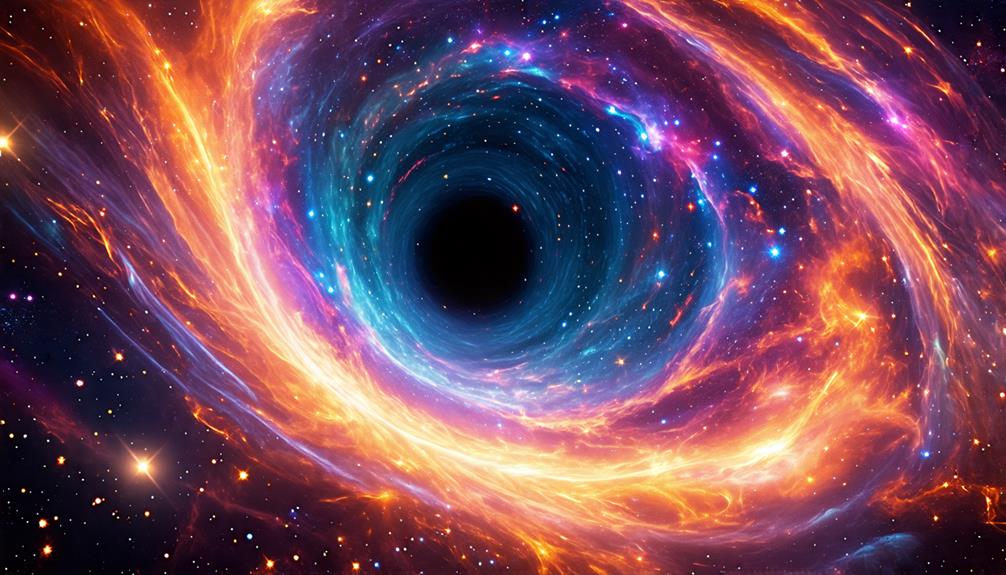
Black holes present a significant challenge to our understanding of physics, particularly through the black hole information paradox. When matter crosses the event horizon, it seems to take its information with it, creating a conflict with quantum mechanics, which posits that information cannot be destroyed. However, emerging theories like the Page curve suggest a more intricate relationship between information and black hole evaporation. What does this mean for our understanding of reality? The answers may be more complex and intriguing than anticipated.
Overview of Black Hole Information Paradox
The black hole information paradox underscores a fundamental conflict between the irreversible nature of black hole evaporation and the principle of information conservation in quantum mechanics. When a black hole emits Hawking radiation, it appears to lose all information about the matter that fell into it, leading to claims of information loss—a notion that contradicts quantum mechanics, which asserts that information cannot be destroyed.
Don Page's Page curve provides insight into this paradox by illustrating how a black hole's entropy changes over time. It suggests that information may be preserved or even released as the black hole evaporates, rather than being lost. However, the debate continues, with physicists questioning whether information truly escapes or remains trapped.
Recent advancements, such as the AdS/CFT correspondence, propose that information within black holes could be stored in ways that challenge conventional understandings of space-time and quantum mechanics. Ultimately, the black hole information paradox raises critical questions about entropy, unitarity, and the fundamental nature of reality, pushing the boundaries of modern physics.
Historical Context and Key Figures

The black hole information paradox, emerging in the 1970s, has sparked intense debate among physicists about the fate of information swallowed by black holes. This paradox challenges the core principles of quantum mechanics, particularly regarding information preservation. Key figures like Don Page have made significant contributions to this field, leading to crucial insights into black hole radiation and its implications for entropy.
Here are some noteworthy points to reflect on:
- Don Page made significant contributions to understanding black holes and their radiation, influencing debates on information loss.
- David Finkelstein established the irreversible nature of black holes in 1958, laying the groundwork for ongoing discussions about information retention.
- The concept of black hole evaporation highlights how black holes might lose mass and potentially release information back into the universe.
These historical contexts and key figures underscore the complexity and relevance of the black hole information paradox, continuing to challenge our understanding of the universe.
Mechanisms of Black Hole Evaporation
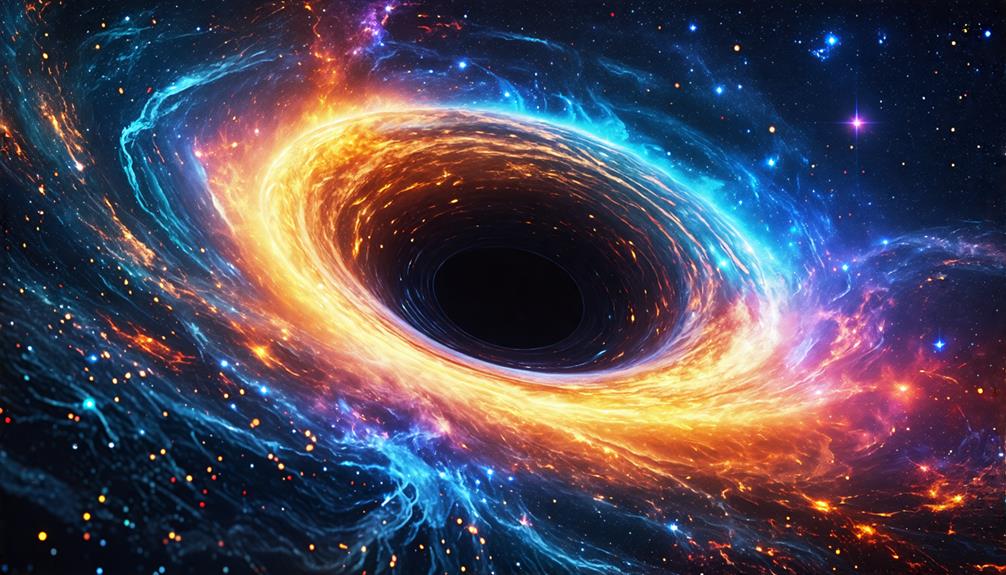
Black holes evaporate primarily through a process known as Hawking radiation, where particle-antiparticle pairs form near the event horizon. As they lose mass, the dynamics of their evaporation change, leading to fascinating outcomes. Understanding the time it takes for different black holes to completely evaporate adds another layer to this intriguing phenomenon, with smaller black holes evaporating faster than larger ones.
Hawking Radiation Process
Hawking radiation arises from quantum effects near a black hole's event horizon, causing it to emit thermal radiation and gradually lose mass and energy. This phenomenon, grounded in quantum mechanics, demonstrates that black holes are not as immutable as once believed. As black holes emit Hawking radiation, they undergo a process known as black hole evaporation, gradually reducing their mass over time.
Key points about Hawking radiation include:
- Temperature Relation: The temperature of the emitted radiation is inversely proportional to the mass of the black hole.
- Bekenstein-Hawking Luminosity: The power of the radiation is described by the formula \( P = rac{\hbar c^6}{15360\pi G^2 M^2} \).
- Mass Loss Dynamics: As black holes lose mass, they become hotter and emit more radiation.
- Lifespan: Smaller black holes evaporate more quickly than larger ones. Solar-mass black holes are estimated to last around \( 10^{67} \) years.
Understanding Hawking radiation reshapes our perception of black holes and their ultimate fate.
Mass Loss Dynamics
Black hole evaporation is a process primarily driven by the emission of Hawking radiation, which leads to gradual mass loss. This phenomenon occurs when particle-antiparticle pairs form near the event horizon, with one particle escaping and the other being absorbed by the black hole. As the black hole loses mass, its temperature increases, accelerating the evaporation process. Notably, smaller black holes emit Hawking radiation more intensely than larger ones, resulting in a faster rate of mass loss.
A crucial concept in understanding black hole evaporation is the Page time, which defines the period it takes for a black hole's entropy to halve. This concept underscores the intricate relationship between mass loss and evaporation dynamics. As a black hole evaporates, its entropy decreases, raising questions about information preservation and the principles of quantum mechanics. The interplay between temperature, mass loss, and Hawking radiation is fundamental to the fate of black holes. Understanding these mechanisms is essential for unraveling the mysteries of black hole evaporation and its broader implications for the universe.
Evaporation Time Estimates
Estimating the evaporation time of black holes reveals significant differences based on their mass. For instance, solar mass black holes are estimated to take around \(10^{67}\) years to evaporate completely, while supermassive black holes may take up to \(2 imes 10^{106}\) years. This vast difference hinges on the Bekenstein-Hawking luminosity, which describes how black holes lose mass through Hawking radiation.
Consider these key points about black hole evaporation:
- Smaller black holes evaporate faster due to their higher temperatures.
- The Page time indicates when a black hole's entropy is expected to halve, marking a significant stage in its evaporation process.
- As black holes lose mass, their emission rates increase, leading to a rapid decline in mass.
- Eventually, black holes may produce explosive gamma-ray emissions as they near dissolution.
These factors highlight the complex interplay between a black hole's mass, evaporation time, and the nature of information loss. Each black hole carries its unique story, bound by the laws of physics, waiting to be unraveled through ongoing research.
Quantum Mechanics and Information Theory

Quantum mechanics fundamentally challenges our understanding of information preservation, especially in the context of black holes and their evaporation processes. The principle of unitarity in quantum mechanics suggests that all information contained in a quantum state can be retrieved, raising questions about whether information is truly lost when a black hole evaporates.
Don Page's 1993 formulation of the Page curve demonstrates how a black hole's entropy changes over time, indicating that information is preserved and potentially released during its evaporation. However, the no-hair theorem complicates matters by stating that a black hole's observable traits—mass, charge, and angular momentum—are all that remains, seemingly erasing other information about infalling matter.
Recent insights into quantum entanglement reveal that emitted Hawking radiation may maintain a quantum link to the black hole. This suggests that information could be encoded within the radiation itself, allowing for the possibility that it can be recovered. As you explore these concepts further, you will find that the intersection of quantum mechanics and information theory creates a complex and fascinating landscape surrounding black holes and their enigmatic behavior.
Role of Hawking Radiation
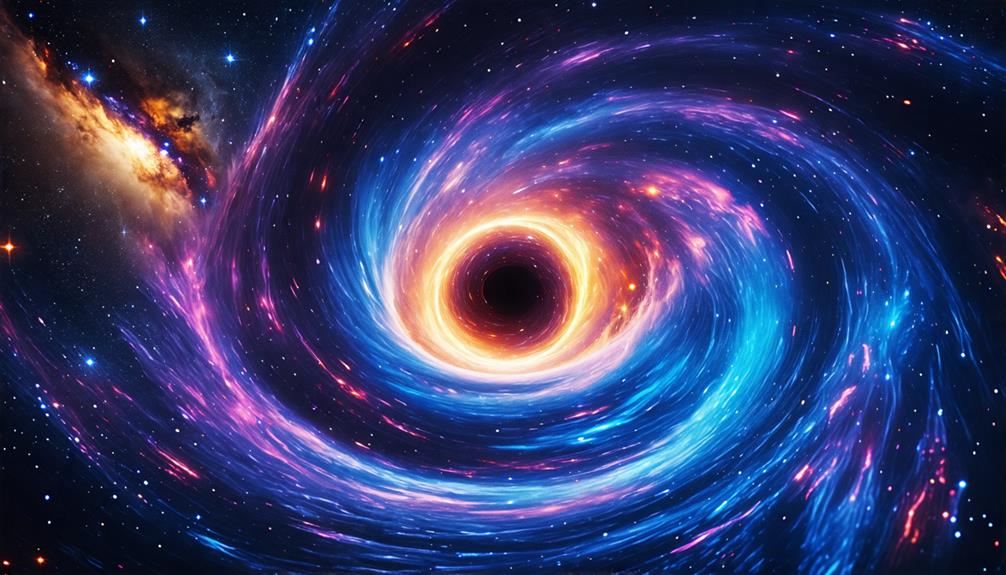
Hawking radiation is crucial for understanding black holes and their dynamics. By examining the quantum effects that drive this emission, significant insights emerge about the potential information loss associated with black holes. This phenomenon intensifies the complexity of the information paradox, highlighting unresolved questions about the ultimate fate of information that enters black holes.
Hawking Radiation Explained
Black holes aren't just cosmic vacuum cleaners; they also emit thermal radiation known as Hawking radiation, a phenomenon arising from quantum effects at their event horizons. Proposed by Stephen Hawking in 1974, this process reveals that black holes can lose mass over time and eventually evaporate.
Key points about Hawking radiation include:
- The temperature of a black hole is inversely proportional to its mass—smaller black holes emit higher temperatures.
- The Bekenstein-Hawking luminosity formula allows for the calculation of the power emitted by a black hole.
- As black holes emit Hawking radiation, they gradually lose mass, significantly affecting their lifespan.
- The evaporation process increases a black hole's temperature, potentially resulting in explosive gamma-ray emissions as it nears its end.
Understanding Hawking radiation clarifies how black holes interact with their surroundings and offers insights into the fundamental nature of reality, reshaping our perception of these enigmatic cosmic entities.
Quantum Effects on Emission
The intricate interplay of quantum effects near a black hole's event horizon leads to the emission of Hawking radiation, fundamentally altering our understanding of these cosmic giants. This theoretical thermal radiation arises when particle-antiparticle pairs spontaneously form just outside the event horizon. One of these particles may fall into the black hole while the other escapes, creating Hawking radiation.
The temperature of a black hole is inversely related to its mass, as indicated by the formula \( T(\infty) = rac{1}{8\pi M} \). Smaller black holes emit radiation at higher temperatures, causing them to evaporate more rapidly than larger ones. The power emitted through Hawking radiation is described by the Bekenstein-Hawking luminosity formula: \( P = rac{\hbar c^6}{15360\pi G^2 M^2} \).
As black holes lose mass through this radiation, their temperature increases, leading to a dramatic endpoint characterized by explosive gamma-ray emissions when they reach a critical size. This phenomenon reshapes our understanding of black holes and relates deeply to the information paradox, raising questions about the fate of information in these extreme environments.
Implications for Information Loss
Understanding how Hawking radiation leads to information loss challenges fundamental principles of quantum mechanics and our perception of reality. When black holes emit Hawking radiation, they gradually lose mass through a process of evaporation. This raises critical questions about whether the information that falls into black holes can ever be retrieved or if it is permanently lost, contradicting the tenets of quantum mechanics.
Key Implications of Information Loss through Hawking Radiation:
- Hawking Radiation: A thermal emission allowing black holes to lose mass over time.
- Evaporation: Smaller black holes evaporate faster due to higher radiation output.
- Temperature: The temperature of a black hole inversely correlates with its mass, affecting its radiation characteristics.
- Bekenstein-Hawking Luminosity: This formula quantifies the power emitted, linking mass and radiation properties.
As black holes approach their final moments, they might emit explosive bursts of radiation, potentially revealing clues about the lost information. However, empirical evidence remains elusive, leaving the debate on information loss unresolved.
The Page Curve Explained

The Page curve elucidates the evolution of the von Neumann entropy of black hole radiation over time. During black hole evaporation, entropy initially increases, peaking at the halfway point known as Page time. This peak signifies that information in the emitted radiation starts to become accessible.
Post-Page time, the curve shows a decline in entropy, indicating that information about the black hole's initial state can be reconstructed from the emitted radiation. In 1993, Don Page's argument challenged the notion that black holes irreversibly lose information, suggesting instead that they preserve it. This insight addresses the longstanding information paradox.
Understanding the Page curve is crucial for aligning black hole behavior with quantum mechanics, particularly the principle that information is never truly lost. Analyzing this curve provides a clearer understanding of black hole entropy, radiation, and the preservation of information during black hole evaporation.
Recent Theoretical Breakthroughs
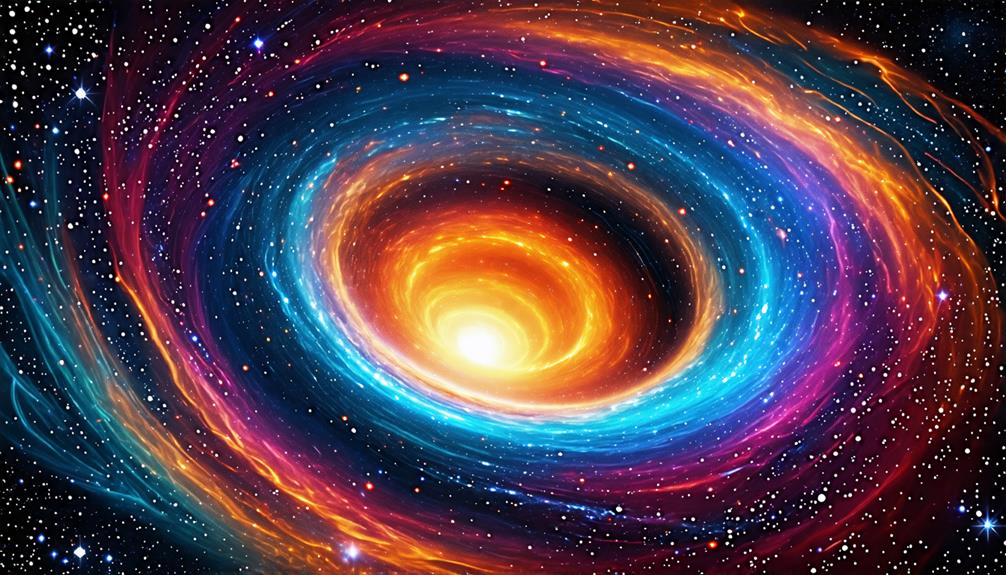
Recent theoretical breakthroughs are transforming our understanding of black holes, especially regarding how information might escape during their evaporation. These advancements challenge the traditional view that information is irretrievably lost, suggesting instead that it can be preserved through a variety of mechanisms.
Key insights from these breakthroughs include:
- The Page time concept, which reveals that black hole entropy reverses halfway through its life, allowing for information preservation.
- Studies on entanglement entropy indicate that as black holes emit radiation, this entropy decreases, maintaining a quantum connection to the black hole's interior.
- The AdS/CFT duality framework links black holes in bulk spacetime to boundary systems, ensuring that information remains intact during black hole evaporation.
- Recent findings suggest that black holes act as complex systems where entanglement dynamics significantly influence information behavior.
These breakthroughs are reshaping our perspective on the black hole information paradox, opening new avenues for exploration in theoretical physics.
Alternative Theories and Critiques

When exploring alternative theories about black holes, concepts such as fuzzballs and information retention hypotheses challenge traditional models. Critics argue that these theories often lack empirical support and complicate our understanding of black hole physics. It is essential to consider these perspectives as the debate over information preservation continues to evolve.
Fuzzballs and Information Accessibility
Fuzzball theory offers a transformative view of black holes, asserting that they preserve information through a complex, string-based quantum structure rather than letting it disappear into a singularity. This contrasts with traditional black hole models that suggest information loss.
Key aspects of fuzzballs and their implications for information accessibility include:
- Information Preservation: Fuzzballs retain all matter and information, unlike conventional black holes.
- Quantum Structure: The model underscores the quantum nature of black holes, complicating the understanding of event horizons.
- Topology: The intricate topology of fuzzballs supports diverse information configurations.
- Hawking Radiation: Fuzzball theory provides new perspectives on the relationship between Hawking radiation and information recovery.
In this context, information is never truly lost, potentially resolving the black hole information paradox and reshaping our understanding of these cosmic phenomena.
Information Retention Hypotheses
Researchers have proposed several theories suggesting that information can escape from black holes rather than being permanently trapped. One prominent idea involves entangled radiation, where emitted particles might carry encoded information about a black hole's interior. This challenges the notion of information loss, which contradicts the principle of information preservation in quantum mechanics.
Samir D. Mathur's fuzzball models offer another perspective on information retention. According to these models, black holes are composed of complex strings instead of singularities, potentially allowing information to be stored and released. Additionally, the concept of wormholes introduces the possibility of connections between black holes, providing pathways for information to escape during evaporation processes.
Recent advancements in quantum extremal surfaces and the AdS/CFT duality have also provided insights into how information might be retained in a non-local manner. These theories suggest that information is not lost but transformed, paving the way for a deeper understanding of black holes. As researchers explore these hypotheses, they continue to refine our understanding of the universe's fundamental laws, keeping the debate on information retention alive and dynamic.
Critiques of Current Models
Critics of current black hole models argue that many proposed theories rely on questionable assumptions and fail to account for the complexities of quantum gravity. They highlight significant gaps in understanding how information loss occurs and challenge the validity of existing models.
- Alternative theories suggest information might escape black holes through mechanisms like wormholes.
- Raju's hypothesis claims information remains preserved outside black holes.
- Samir D. Mathur's 'fuzzball' model argues that black holes never fully form, avoiding the information paradox.
- Critics find that models by Almheiri, Engelhardt, and Penington seem contrived and depend on unverified assumptions.
This ongoing debate reveals that black hole evaporation and information dynamics under semiclassical treatments may require substantial modifications. Recognizing these critiques is crucial in the quest for a cohesive theory, posing profound questions about the nature of black holes and the universe itself.
Implications for Physics and Cosmology
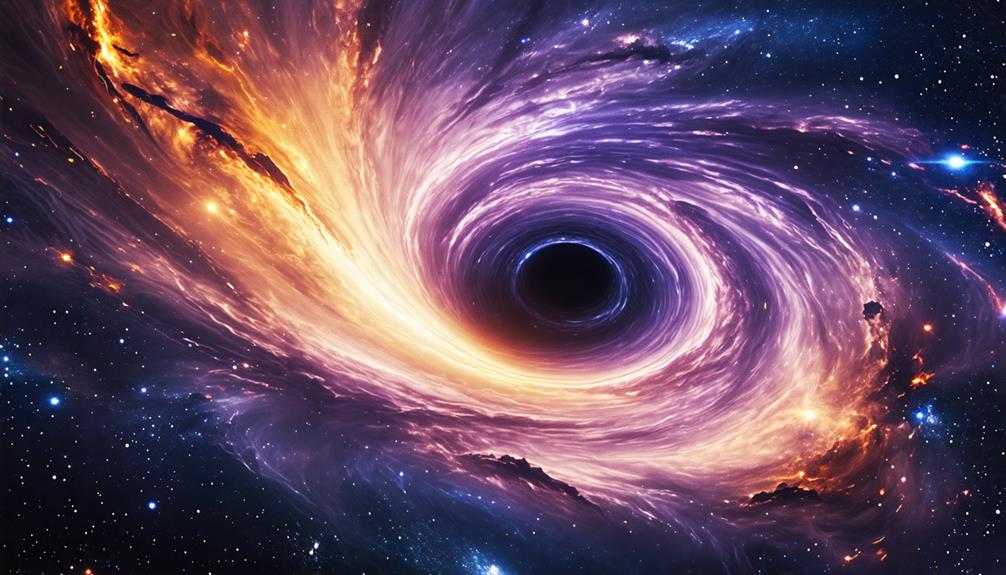
The black hole information paradox poses significant challenges to our understanding of fundamental physics and cosmology, prompting a reevaluation of how information is preserved in the universe. This paradox arises from the apparent conflict between black hole evaporation and the principles of quantum mechanics, which assert that information cannot be destroyed.
Recent advancements suggest that information may escape black holes through emitted radiation, a finding that contradicts earlier beliefs about irreversible information loss. The Page curve, which illustrates the behavior of entropy during black hole evaporation, indicates that entropy can decrease, hinting at mechanisms for information preservation.
Here's a concise overview of these concepts:
| Concept | Description | Implications |
|---|---|---|
| Black Hole | A region where gravity prevents the escape of anything, including light | Challenges conventional notions of information retention |
| Information Paradox | The idea that information is lost when black holes evaporate | Conflicts with quantum mechanics principles |
| Quantum Entanglement | Phenomenon where particles remain interconnected, potentially carrying information | May preserve information in emitted radiation |
| Event Horizon | The boundary around a black hole beyond which nothing can escape | Defines the limits of observation and information flow |
| Page Curve | A graph showing the behavior of entropy during black hole evaporation | Suggests possible mechanisms for information retention |
These insights have the potential to reshape our understanding of the universe.
Future Directions in Research

Future research on the black hole information paradox aims to unravel the complexities of quantum entanglement and its role in preserving information during black hole evaporation. As scientists delve deeper into this enigma, several promising directions are emerging:
- Investigating quantum extremal surfaces that may allow information to escape black holes.
- Exploring how Hawking radiation might carry encoded information, challenging the idea of irreversibility.
- Developing theoretical models that integrate gravity with quantum mechanics, particularly through the lens of AdS/CFT duality.
- Conducting experimental efforts to detect gamma-ray emissions from evaporating black holes, potentially providing direct evidence of information leakage.
These research avenues aim to clarify the relationship between quantum mechanics and black holes, particularly regarding the information paradox. By addressing these fundamental questions, researchers are not just contributing to theoretical physics; they may also uncover insights that reshape our understanding of the universe itself. The exploration into the heart of black holes promises to be as fascinating as it is complex.
Conclusion
In exploring the black hole information paradox, you've encountered profound questions about the nature of reality. Although Hawking radiation offers a potential solution, the debate continues among physicists regarding whether information truly vanishes or somehow escapes. These discussions extend beyond black holes, challenging our understanding of quantum mechanics and the universe. As research progresses, you can anticipate groundbreaking developments that may fundamentally reshape our understanding of physics.




